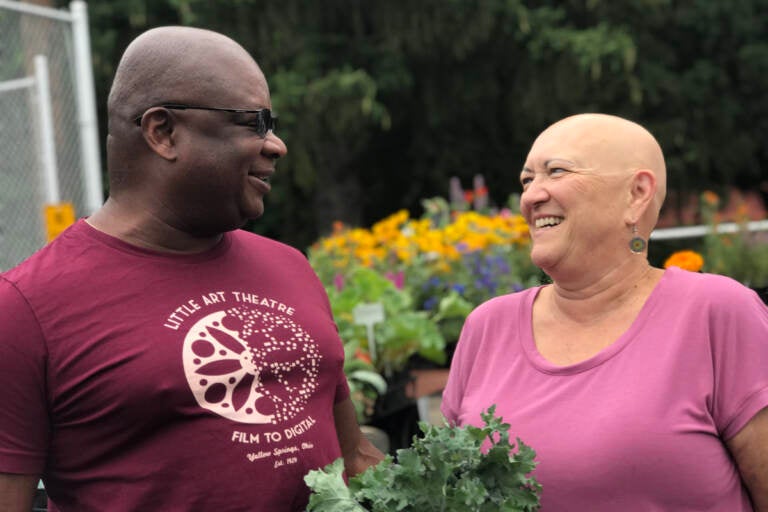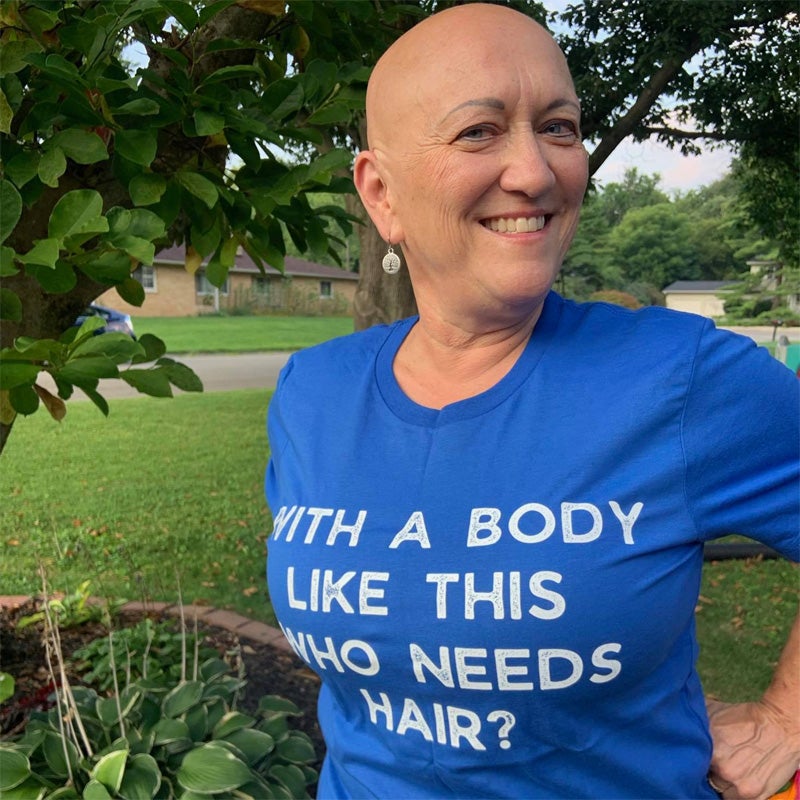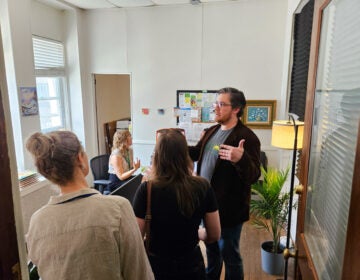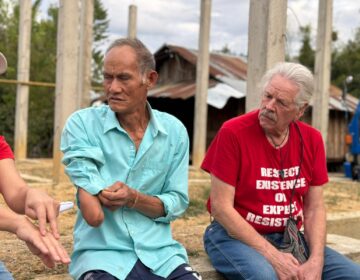Going wig-less — learning to live with alopecia
In movies, bald women are portrayed as strong; in real life, they’re seen as odd. One woman gradually decided to just go with it.
Listen 7:31
Kevin and Karen Gardner at the farmer’s market in Yellow Springs, near Dayton, Ohio. (Jocelyn Robinson/For WHYY)
This story is from The Pulse, a weekly health and science podcast.
Subscribe on Apple Podcasts, Spotify or wherever you get your podcasts.
Bald men are often considered daring, intelligent, or sexy — think Dwayne Johnson, Sir Patrick Stewart, or LL Cool J. But bald women are not, though Danai Gurira and “Black Panther’s” female warriors, the Dora Milaje, might be improving the image of hairless women.
More often, a woman without hair is viewed as an oddity, or someone who is unwell — someone to be pitied.
Hair loss has many causes, including illness, chemotherapy, and heredity. Then there’s alopecia. Over 6 million people of every sex and racial identity experience some form of it. With few effective treatments and no known cure, doctors don’t even know what causes it.
Karen Gardner has lived with alopecia for decades. Every Saturday morning, Gardner and her husband, Kevin Stokes, visit the farmer’s market in Yellow Springs, a village east of Dayton, Ohio, to nab some organic kale and catch up with their neighbors, since they’re all still emerging from pandemic isolation.
The couple is well known in their small community. She’s an accomplished pianist who chairs the local chamber music festival, and he serves on the Village Council. She’s white, he’s Black. They’re outgoing, friendly.
And, Gardner said, their appearance is memorable.
“One friend of ours calls us cue ball and eight ball,” she said. Because both of them are bald. Stokes shaves his head, but Gardner has alopecia universalis, and it’s caused her to lose the hair all over her body, permanently.
When she was in her early 30s, she was getting her hair cut, and the stylist said, “Do you know that you’re missing some hair in the back of your head?” She said, ‘no,’ and within six months she had lost all of her hair.
Gardner spent years undergoing a lot of different treatments. She went to some very good doctors. She had a lot of injections in her head. When she started losing her eyebrows, she had painful injections in her face. She tried creams, and Rogaine for a while, but nothing helped. Finally, she just gave up — she was devastated, embarrassed, and self-conscious.
Because she lives in a place where everybody knows everybody, Gardner wanted to hide what was happening. She didn’t let anybody see her without a wig or without a hat on. And she let it change her life. She remembered going to the beach when her children were young, and she wouldn’t go in the water because it meant she had to take off her wig.
Even though she knew she looked more “normal” with a wig on, she was very aware of the wig, and it was uncomfortable. She was always fidgeting and pulling it down, and was very self-conscious about people seeing that she was wearing a wig.
But one day, about 15 years after she’d lost her hair, something flipped, and Gardner made a change.
She was at a music festival, and she was very hot. She remembered seeing a young woman who wasn’t bald but had her blonde hair very closely cropped so she almost looked bald. Gardner thought, “Why am I doing this?” She went into the portable toilet and took her wig off, then went out and kept dancing without her hair.
And since then, the wig has stayed off.
“When I stopped wearing wigs, I was self-conscious in a different way, but it changed and I felt freer after a while because now people see what they see,” she said. “They see that I don’t have hair. I know they see that. So I’m aware of it, but I forget about it sometimes. And I just don’t care as much because I know that they see what they see. I’m not trying to cover up who I am or how I am.”

Subscribe to The Pulse
Though Gardner has had eyebrow and eyeliner tattoos, and she has a penchant for wearing long, dangly earrings, her friends and family think she’s very brave for going through the world without hair. But she doesn’t feel brave at all, she said — she just feels like she’s reached a level of acceptance, and without wearing a wig, she forgets that she has alopecia.
She’ll be walking down the street, she said, and somebody will say something to her.
“Usually they’re trying to be kind,” Gardner said. “I’ve had people come up and just say, ‘You look beautiful,’ you know, or ‘You’re rocking that,’ or also just asking me if I have cancer, just all kinds of comments.”
She knows people are trying to be nice, but she said it brings it back to reality that she looks different, and that everybody is noticing.
“I wish people would realize that when they go up to somebody who’s different, and say something to them, even if it’s kind, they’re still reminding that person that they look different. And I’ve had people say outrageous things to me. Early on, I was talking to somebody about it, and I said something about having lost my hair. And they said, ‘Well, at least you didn’t lose an arm.’ True story.”
It’s been a slow process, Gardner said, but she’s a long way from where she started.
She feels as if she’s dealt with her hair loss, and that she doesn’t need to talk about it in a support group.
“There’s no fighting it,” she said. “It helps a lot to be OK in your skin and, you know, I haven’t always felt that way about my body in many different ways, but this is one thing I’ve really come to accept.”
It’s taken her years, but it’s not something Gardner wants to focus on. She doesn’t blame people who do, but she’s just not at that place in her life anymore.
Jocelyn Robinson is producer for Emerging Initiatives, Education and Archives at The Eichelberger Center for Community Voices at WYSO based in Yellow Springs, Ohio.
Support for WHYY’s coverage on health equity issues comes from the Commonwealth Fund.
WHYY is your source for fact-based, in-depth journalism and information. As a nonprofit organization, we rely on financial support from readers like you. Please give today.






